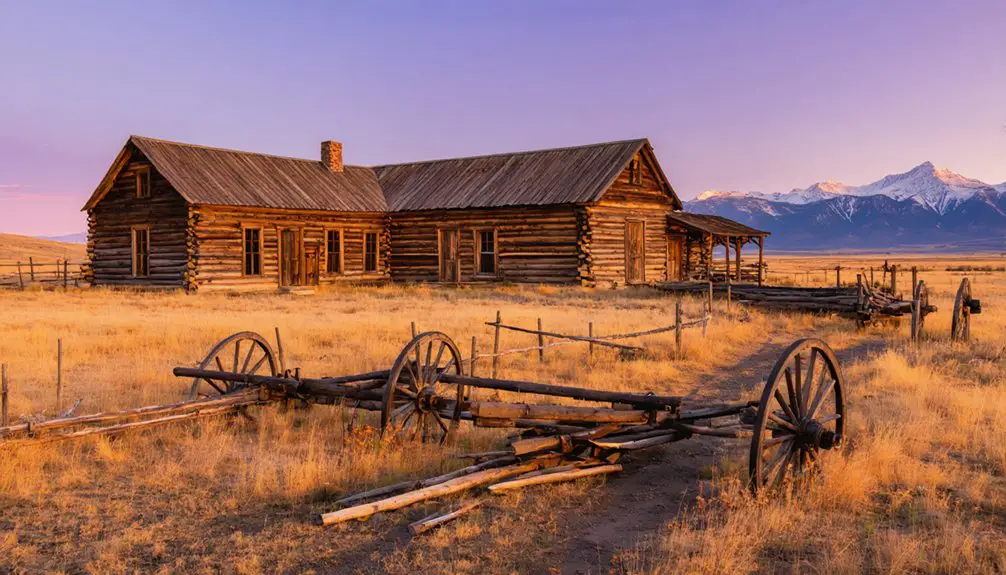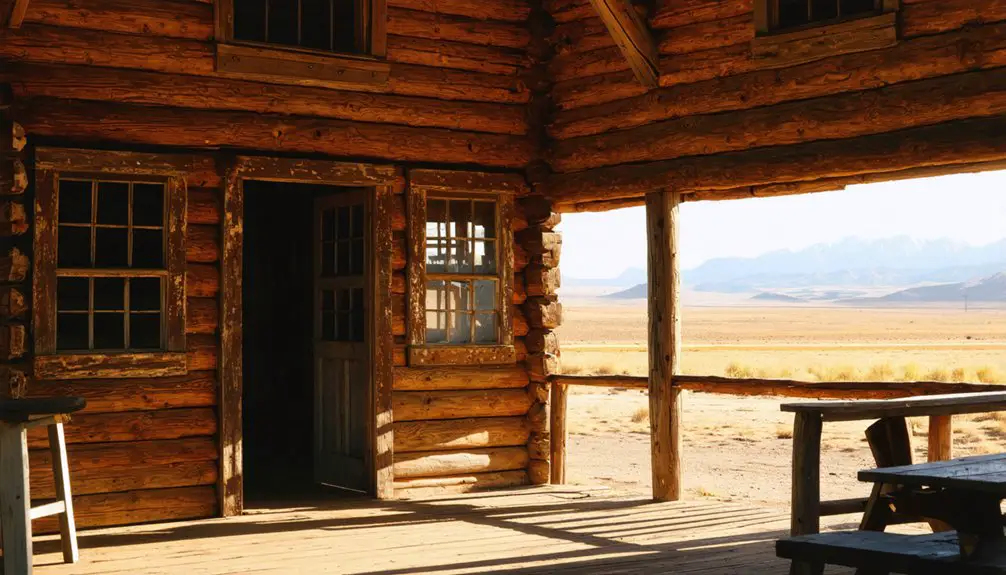You’ll find Fort Bridger’s haunted ruins nestled in Wyoming’s historic Black’s Fork Valley, where Jim Bridger established his trading post in 1842. The site features reconstructed buildings, military barracks, and a cemetery where visitors report ghostly encounters with a mysterious figure in a white cowboy hat. As a vital waypoint along the Oregon Trail, this former frontier outpost served countless pioneers before becoming a military fort. The grounds hold centuries of stories waiting to be uncovered.
Key Takeaways
- Fort Bridger is not technically a ghost town, as it remains an active historic site and museum in Wyoming.
- Founded in 1842 by Jim Bridger and Louis Vasquez, the fort served as a vital trading post along westward migration routes.
- Original structures included two double-log houses and trading facilities, which have been carefully reconstructed for historical preservation.
- The site features reported paranormal activity, including a ghostly figure in a white cowboy hat patrolling the cemetery.
- The fort complex includes preserved military buildings, trading post reconstructions, and interpretive exhibits showcasing Wyoming’s frontier history.
The Birth of a Trading Post (1842-1843)
When Jim Bridger and Louis Vasquez established Fort Bridger in 1842, they created what would become one of the most strategically important trading posts along the western migration routes.
You’ll find the original site nestled in the valley of Blacks Fork of the Green River, where they constructed two double-log houses with a horse pen between them.
Their vision for managing frontier challenges proved astute, as they equipped the post with essential facilities like a blacksmith shop and carpenter’s bench. As a pioneer and trapper, Bridger’s extensive knowledge of the region made him an invaluable resource for travelers.
By early 1843, they’d opened for business, cultivating trading relationships with nearby tribes including the Snakes, Crows, Oglalas, Sioux, Arapahoes, Cheyennes, and Utes.
Fort Bridger flourished through vital trading alliances with seven regional tribes, becoming a crucial link between Native peoples and westward settlers.
The eight-foot stockade surrounded four log cabins, creating a self-sufficient outpost that would serve countless emigrants on their westward journey. The enterprising trader claimed 3,800 acres surrounding the fort in March 1854.
Life Along the Oregon Trail
As thousands of emigrants made their way across the American frontier, Fort Bridger emerged as an essential waystation along the Oregon Trail by 1843.
You’d find this strategic outpost at the crossroads of multiple westward routes, where the main trail split toward Fort Hall and the Great Salt Lake Valley.
After weeks of grueling travel, you could rest while blacksmiths repaired your wagon and tools.
Though prices ran high, you’d trade with local Native Americans and stock up on critical supplies before tackling the challenging terrain ahead.
The fort’s log cabins and stockade offered welcome shelter, while its position along the Blacks Fork of the Green River provided important access to water.
Fort Bridger’s services proved indispensable, supporting emigrant experiences with repairs, provisions, and safe harbor before continuing west.
The trading post, founded by Jim Bridger and Vasquez, initially consisted of two double-log houses where mountain men gathered to exchange goods.
The fort later became a crucial stop for the Pony Express as communication routes expanded across the frontier.
Mormon Conflicts and Military Confrontations
Following years of mounting tensions, the Mormon militia’s takeover of Fort Bridger in 1854 ignited a complex series of conflicts between Mormon settlers and federal authorities. Under Brigham Young’s direction, armed men seized control of the fort and nearby ferries, forcing Jim Bridger to flee after accusations of illegal trade with Native Americans. In August 1855, Bridger agreed to sell the fort for eight thousand dollars with a partial down payment.
When President Buchanan deployed 2,500 federal troops to Utah in 1857, the Mormon militia responded with strategic defensive tactics. They fortified Echo and Weber Canyons, burned grasslands, and destroyed Fort Bridger to prevent federal occupation. The Nauvoo Legion was reactivated to coordinate defensive operations against approaching federal forces.
The militia’s hit-and-run raids disrupted army supply lines while avoiding direct combat. At 7,000 feet elevation, harsh winters further complicated military movements, transforming Fort Bridger into an essential battleground in the struggle between Mormon autonomy and federal control.
Tales From the Fort Bridger Cemetery
You’ll find documented accounts of a mysterious figure in a white cowboy hat who patrolled Fort Bridger Cemetery nightly in 1987, with multiple witnesses including the caretaker reporting these encounters.
Historical records connect this apparition to a deceased husband who seemingly stood eternal guard until his wife’s passing in 1988, after which the sightings ceased.
Through detailed investigation and eyewitness testimony, researchers have uncovered additional paranormal phenomena at the cemetery, including reports of spectral military personnel still maintaining their posts and grieving spirits of early settlers lingering near their graves.
Among the most notable spirits said to roam the grounds is Judge William Carter, who served as both merchant and sutler after arriving with the U.S. Army in 1857.
The site’s haunted reputation grew after the construction of the original double-log houses in 1843, which still stand as silent witnesses to centuries of history.
Mysterious Midnight Encounters
While many historic sites boast supernatural tales, Fort Bridger Cemetery‘s documented midnight encounters present a particularly compelling collection of paranormal activity.
You’ll find three distinct spectral legends consistently reported since the 1980s: a male spirit searching for his deceased wife, a dutiful ghost inspecting graves, and a protective animal presence patrolling the grounds.
The most frequently documented ghostly sightings occur between midnight and dawn, when visitors report encountering a man in a white cowboy hat wandering among the headstones. First spotted by the cemetery caretaker in 1987, the mysterious figure became a regular presence at the historic grounds. Located off Interstate Highway 80 West, the cemetery remains accessible to those seeking supernatural experiences.
After his wife’s death in 1988, these appearances ceased, lending credibility to local beliefs.
Meanwhile, a separate military-linked entity continues his eternal guard duty, tending to graves under cover of darkness, while an ethereal canine companion maintains its own vigilant watch over this historic resting place.
Eternal Guard Duty
The most enduring legend at Fort Bridger Cemetery centers on a devoted spirit who maintains an eternal watch over the hallowed grounds. Since 1987, visitors have reported encounters with a ghostly figure in a white cowboy hat, embodying spectral guardianship over the historic burial ground.
The apparition’s ghostly loyalty ties directly to a local tale of a man who couldn’t bear leaving his deceased wife. After the widow’s death in 1988, the sightings mysteriously ceased, lending credence to this narrative of undying devotion.
You’ll find this story deeply woven into the cemetery’s broader historical significance, where notable pioneers like “Uncle Jack” Robertson and Judge William Carter rest. The legend perfectly captures the frontier values of honor and protection that defined Fort Bridger’s military past.
Grieving Spirits Linger
Since Fort Bridger Cemetery‘s establishment in 1868, numerous accounts of grieving spirits have emerged from this historic burial ground.
Among the most compelling tales of spectral love comes from 1987, when the cemetery caretaker witnessed a figure in a white cowboy hat wandering between the graves. This apparition, identified as a recently deceased local man, seemed to maintain grief’s legacy by watching over his widow until her passing in 1988.
- The ghost ceased appearances after his widow’s death, suggesting a reunion in the afterlife
- Local narratives emphasize how these spirits embody frontier hardships
- The cemetery preserves 71 graves, including two unidentified souls
- Visitor accounts continue fueling paranormal tourism at this Wyoming landmark
Historic Buildings and Their Ghostly Residents
Originally constructed as a humble trading post in 1842, Fort Bridger’s historic buildings tell fascinating stories of both living residents and supernatural phenomena.
The fort began as two double-log houses with a horse pen, later expanding to include four cabins within an eight-foot stockade. You’ll find traces of its evolution through the Mormon-built stone wall and military-era structures, though many were relocated after the fort’s abandonment.
While exploring the restored trading post and archaeological sites, you might encounter some of the fort’s reported spectral residents.
Staff and visitors have documented ghostly encounters throughout the grounds, particularly in the cemetery where an old military spirit inspects graves.
These supernatural claims, though unproven, align with the site’s rich history of frontier life, military operations, and personal tragedies.
Strategic Importance in Western Settlement

Located at an essential intersection of major westward routes, Fort Bridger emerged as one of the most significant outposts for America’s western expansion during the mid-19th century.
As migration patterns shifted from fur trading to settler colonization, the fort adapted to serve diverse frontier economy needs, becoming an important supply hub for those seeking freedom in the West.
- You’ll find evidence of its strategic value as the second most important outfitting station after Fort Laramie for Pacific Coast-bound travelers.
- The site supported multiple transportation networks, from wagon trains to the Pony Express.
- Its military presence helped secure important communication and commerce routes.
- The fort facilitated economic exchanges between Native Americans, settlers, and traders through its trading post operations.
Paranormal Activities and Unexplained Events
Whether due to its rich history or atmospheric setting, Fort Bridger has gained a reputation as one of Wyoming’s most haunted locations.
You’ll encounter reports of ghostly whispers throughout the fort’s historic structures, particularly in the old barracks and trading post dating to the 1840s. The cemetery stands as a focal point for spectral sightings, where visitors report a military spirit meticulously inspecting graves and another male presence waiting eternally for his deceased wife.
The fort’s paranormal activity extends beyond human spirits. You might feel the presence of a legendary ghost dog, known for brushing against visitors’ legs, while shadowy miners with flickering headlamps are frequently spotted near disaster sites.
Modern paranormal investigators continue documenting these phenomena using specialized equipment during research events and tours.
Preserving Wyoming’s Frontier Heritage
Beyond the ghostly tales and supernatural occurrences, Fort Bridger stands as a tribute to Wyoming’s pioneering spirit through active preservation efforts.
You’ll discover how this historic site tackles preservation challenges while delivering heritage education through restored buildings, artifacts, and living history programs.
- Original trading post structures have been meticulously reconstructed, including double-log houses and a blacksmith shop that mirror Jim Bridger’s 1843 design.
- The site serves as a vital educational hub for understanding Native American relations and westward expansion.
- Local historical societies and volunteers work alongside state agencies to maintain authentic interpretations.
- Archaeological research continues to uncover new insights while balancing restoration needs.
Today’s preservation work guarantees that Fort Bridger’s role in frontier commerce, military operations, and cultural exchange remains accessible for future generations to explore and understand.
Frequently Asked Questions
What Native American Tribes Regularly Traded at Fort Bridger?
Like an ancient Walmart, Fort Bridger drew you into a vibrant trading hub where Shoshone trade dominated alongside Crow, Oglala Sioux, Arapaho, Cheyenne, and frequent Ute interactions for essential supplies.
How Many People Died at Fort Bridger During Its Active Years?
You won’t find exact death counts in historical accounts, as records weren’t systematically kept for the fort’s population. While deaths certainly occurred from 1843-1890, documented evidence remains sparse and scattered.
What Happened to Jim Bridger’s Personal Belongings After Leaving the Fort?
You’ll find that Bridger’s legacy was largely erased when his personal belongings were destroyed in the 1853 fort burning. Historical artifacts were lost forever during Mormon militia control.
Were There Any Documented Murders or Executions at Fort Bridger?
You’ll find documented murders around Fort Bridger, including Jeff Green’s brutal 1979 killing and a recent shooting. The most notable execution’s Mark Hopkinson’s 1992 death for ordering Green’s murder.
What Was the Fort’s Role in the American Civil War?
You’ll find the Civil War’s western impact reflected here through its strategic location, serving as an essential supply station while volunteer units manned operations after regular troops headed east to fight.
References
- http://hauntedhouses.com/wyoming/fort-bridger/
- https://www.legendsofamerica.com/wy-fortbridger/
- https://fossilbasin.org/2024/10/29/fossil-basins-phantoms-and-haunted-places/
- http://www.historyglobe.com/ot/ftbridger.htm
- https://www.wyohistory.org/encyclopedia/fort-bridger
- https://wyoshpo.wyo.gov/index.php/programs/national-register/wyoming-listings/view-full-list/897-fort-bridger
- https://en.wikipedia.org/wiki/Fort_Bridger
- https://jacobbarlow.com/2018/03/30/old-fort-bridger-pioneer-trading-post/
- https://americasbesthistory.com/spotlight2022-10.html
- https://historicwyoming.org/profiles/laststopfortbridger/



